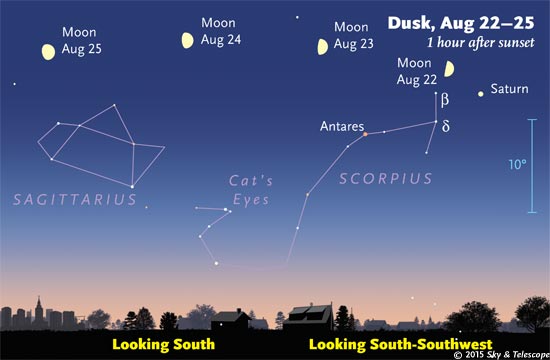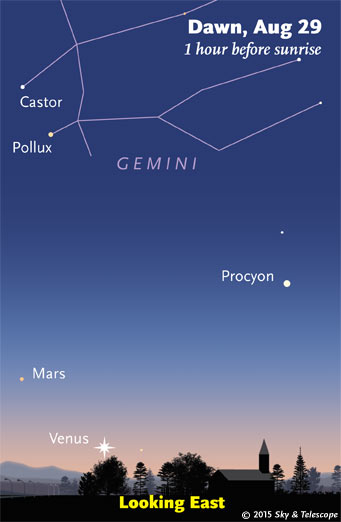Friday, August 21
• The bright "star" left of the Moon this evening is the planet Saturn. Lower left of Saturn is fainter Delta (δ) Scorpii. Farther left or lower left sparkles the orange-red supergiant Antares.
Saturday, August 22
• First-quarter Moon (exact at 3:31 p.m. EDT). As dusk fades, the Moon shines near Saturn and Beta (β) Scorpii, as shown below. Beta is fine double star for small telescopes. So is Nu Scorpii, upper left of Beta by 1.6°. (Nu is a little too faint for the chart.)

Sunday, August 23
• The Moon forms a right triangle this evening with Antares below it and Saturn to Antares's left. Or, an almost right triangle — depending on where you are and when you look. Can you see the triangle change shape in the course of the evening? The Moon, in its orbit around Earth, is moving eastward against the stars.
Monday, August 24
• The two brightest stars of summer are Vega, overhead soon after dark, and Arcturus, declining ever lower in the west. The name Vega comes from an ancient Arabic phrase for "the diving eagle." Arcturus is from ancient Greek for "bear watcher" or "bear guardian," referring to the way it follows Ursa Major, the Great Bear, around the sky.
• The brightest part of the Bear, the Big Dipper, is dipping down well to the right of Arcturus, in the northwest.
Tuesday, August 25
• At nightfall, the waxing gibbous Moon shines above the tilting Sagittarius Teapot. The Teapot pattern is about as big as your fist at arm's length, with its spout to the right.
Wednesday, August 26
• As the stars begin to come out, look upper left of the Moon by about two fists at arm's length for Altair. How early can you see it? With the steady turning of the sky (or rather the Earth), Altair stands directly above the Moon by about 10:30.
Thursday, August 27
• The bright Moon after dark shines just above the dim boat-shape of Capricornus. How much of it can you see through the glare? Look about a fist to the Moon's right for dim Alpha Capricorni, a double star that's just resolvable with the naked eye. Binoculars show Alpha as twins beautifully. About half a binocular field below or lower left of Alpha is Beta Cap, a less easy double star for binoculars.
Friday, August 28
• By the time it gets fully dark now, Cassiopeia has risen as high in the northeast as the Big Dipper has sunk in the northwest. Midway between them, and a little higher, is Polaris.
Saturday, August 29
• Full Moon (exact at 2:35 p.m. Eastern Daylight Time). Well to the Moon's left or upper left this evening, look for the Great Square of Pegasus balancing on one corner. It's a bit larger than your fist at arm's length.
__________________________
Want to become a better astronomer? Learn your way around the constellations. They're the key to locating everything fainter and deeper to hunt with binoculars or a telescope.
This is an outdoor nature hobby. For an easy-to-use constellation guide covering the whole evening sky, use the big monthly map in the center of each issue of Sky & Telescope, the essential guide to astronomy.

Once you get a telescope, to put it to good use you'll need a detailed, large-scale sky atlas (set of charts). The standards are the little Pocket Sky Atlas, which shows stars to magnitude 7.6; the larger and deeper Sky Atlas 2000.0 (stars to magnitude 8.5); and once you know your way around, the even larger Uranometria 2000.0 (stars to magnitude 9.75). And read how to use sky charts with a telescope.
You'll also want a good deep-sky guidebook, such as Sue French's Deep-Sky Wonders collection (which includes its own charts), Sky Atlas 2000.0 Companion by Strong and Sinnott, the bigger Night Sky Observer's Guide by Kepple and Sanner, or the beloved if dated Burnham's Celestial Handbook.
Can a computerized telescope replace charts? Not for beginners, I don't think, and not on mounts and tripods that are less than top-quality mechanically (meaning heavy and expensive). As Terence Dickinson and Alan Dyer say in their Backyard Astronomer's Guide, "A full appreciation of the universe cannot come without developing the skills to find things in the sky and understanding how the sky works. This knowledge comes only by spending time under the stars with star maps in hand."
This Week's Planet Roundup

Mercury (magnitude 0.0) lurks very low in bright twilight due west. About 20 minutes after sunset, use binoculars or a wide-field telescope to scan for it just above the horizon. (Don't confuse it with twinkly Spica, far left and somewhat higher.)
Venus (magnitude –4.2) emerges into dawn visibility by about August 24th. Look just above the east horizon 30 minutes before your local sunrise. (It's lower right of much fainter Mars.) Venus moves rapidly higher day by day.
Mars, a mere magnitude +1.8, rises before the beginning of dawn well before Venus rises. Look for Mars low in the east-northeast about 60 minutes before sunrise, as shown here. Pollux and Castor are above it. Brighter Procyon is off to its right or upper right.
Jupiter is hidden in conjunction with the Sun.
Saturn (magnitude +0.5, in Libra) shines in the southwest at dusk, to the right of upper Scorpius. Fiery orange Antares, less bright, twinkles 13° to Saturn's left or lower left. Delta Scorpii shines more or less between them.
Uranus (magnitude +5.7, in Pisces) and Neptune (magnitude +7.8, in Aquarius) are well up in the southeastern sky by midnight. Finder charts for Uranus and Neptune.
__________________________
All descriptions that relate to your horizon — including the words up, down, right, and left — are written for the world's mid-northern latitudes. Descriptions that also depend on longitude (mainly Moon positions) are for North America.
Eastern Daylight Time (EDT) is Universal Time (UT, UTC, or GMT) minus 4 hours.
__________________________
“This adventure is made possible by generations of searchers strictly adhering to a simple set of rules. Test ideas by experiments and observations. Build on those ideas that pass the test. Reject the ones that fail. Follow the evidence wherever it leads, and question everything. Accept these terms, and the cosmos is yours.”
— Neil deGrasse Tyson, 2014
 0
0
Comments
You must be logged in to post a comment.